-
Nothing is left of Gilman but a hole in the ground (project update).
-
Well that was odd. The Valley News reports that the NewVistas Foundation plan for a 20,000-person new town in Vermont has been abandoned.
-
The Valley News reports on the decline of “WinCycle, the Windsor nonprofit that for 16 years has been taking discarded computers and electronic equipment from Dartmouth-Hitchcock Medical Center and Dartmouth College, refurbishing it, and reselling the equipment[.]”
-
A lot of naming is going on. The Valley News reports on the DEN becoming the Magnuson Family Center, to be located in the new Thayer building; the Grad School has been named for Frank Guarini ’49 (Dartmouth News); and the college is offering a large donor the chance to rename the Norris Cotton Cancer Center (Valley News). It did always seem a little odd that the center was named for the legislator who wangled the federal funding to establish it.
-
The WRJ historic district is expanding to include an area that an architectural historian calls Little Italy (Valley News). The Polka Dot will be saved (Valley News).
-
The Hood staff are moving into the expanded museum, but the opening will not take place until 2019 (Dartmouth News).
-
Hey look! The Dartmouth 250 logo has gone from four fonts to one, and that one is Dartmouth Ruzicka: Dartmouth 250.
-
The Valley News reports that Nick Zwirblia has written a novel, The Bramford Chronicles, Book I: Johnny & Baby Jumbo. You might know Mr. Zwirblia better as the Happy Hop Guy.
-
Rauner had an exhibit on the history of the Ledyard Canoe Club.
-
The Valley News business magazine, Enterprise, has an article on the Grafton County Farm, a government operation that once might have been called a “poor farm.” Grafton County’s is still operating.
-
The capital campaign confirms in a general way some building projects:the Dartmouth Hall renovations; the Hood and Hop expansions and renovations, totaling $125m; and residence hall construction including 356 beds worth of dorms for $200m. There is no word on whether the Hop expansion will follow what seems to be a smart design from 2013 by Bora Architects. There is also talk of a request for a $50m endowment for the six house communities. One hopes that each house is endowed individually (starting at, say, $8m apiece) and is named by its benefactor.
-
The Dartmouth Hall renovation plan is based on an unusual pitch for funding by women (see Inside Higher Ed). More than a century ago, the college targeted the somewhat-arbitrary classification of Massachusetts alumni as a funding source for a new dormitory.
-
Several campus buildings are getting solar panels on their roofs (The Dartmouth).
-
There was a lot of news last April about the shuttering of UPNE, the University Press of New England (The Dartmouth, Inside Higher Ed, Valley News).
-
Students are working on a new historical accountability project that will focus on the role of slavery in Dartmouth’s founding and early history (Dartmouth News).
-
On Tuck Drive, “[c]onstruction also would add a sidewalk and bike lanes to the road, which is about 20-feet wide, Worden said” (Valley News). That is unfortunate. It’s hard to see how the historic granite curbing and guttering (not to mention the retaining walls) could be preserved if a sidewalk were added. Could the college use a row of poles to delineate a sidewalk on the existing asphalt surface? The fact that Italian immigrant labor gangs built that road by hand while living in huts nearby, probably on the site of the Boathouse parking lot, is still fascinating.
-
A corrected article on the Gilman and Dana work in the Valley News states that “Broemel said that plans for a north campus academic center during the 3-year tenure of then-Dartmouth President Jim Yong Kim had spurred discussion about the best use of the buildings, although Kim’s specific idea never came to fruition.” That point deserves more attention: Gilman and Dana were left vacant and available for the current redevelopment because the large North Campus Academic Center by Kyu Sung Woo Architects of Cambridge was meant to be built in their place. (Mr. Woo, incidentally, has a remarkable weekend house in Putney, Vermont.)
-
The Class of 67 Bunkhouse at Moosilauke has been completed (TimberHomes LLC).
Category Archives: Academic Center
Incubator progress; other items
- A nice Burakian aerial from above the Chase Field athletic complex in the foreground shows the potential of Piazza Nervi.
- A little more on the NCAC: it was not noted before in reference to the Alex Atwood rendering that the building’s extensive underground space was to have had at least two skylights in aboveground lanterns, almost like Pei’s Pyramid at the Louvre.
- More on Hillflint, the clothing company mentioned here in October, from Dartmouth Now. Turns out it was started by John Shi ’12.
- The school’s Flickr photostream has a photo of the interior of Rauner showing some of the presidential portraits. I don’t recognize the background of President Kim’s portrait — a room in Baker, perhaps?
- Outgoing Board Chair Steve Mandel did not mention any potential construction when he wrote:
[T]he new living arrangements will embrace the concept of the “house system.” Students will live together not only in their freshman year but also in upper-class residence clusters for their three remaining years. Investments in academic programming and affiliated faculty are planned to foster community in these residential clusters… These changes should reintroduce a dorm-based sense of identity for undergraduates.1Letter from Chairmain of the Board of Trustees Steve Mandel (21 March 2014).
- The Big Green Alert Blog dissects the seating figures for the new West Stands with reference to an article on the project in The D. It looks like the replacement stands will cost 2,312 seats. For reference, the current capacity of all of the stands at Memorial Field in total is about 13,000.
- The D also writes on a planned expansion of the enrollment, faculty, and curriculum of Thayer School. No word yet on new buildings, but they seem inevitable, especially on the parking lot south of the McLean ESC.
- An Incubator progress photo has been posted by Dartmouth Entrepreneurial Network. Four Currier does seem a great place for it — downtown, in a commercial building, and yet on college property right next to campus. NHBR article notes the hiring of director Jamie Coughlin from the abi Innovation Hub in Manchester. An article in BusinessNH Magazine paraphrases Coughlin:
He says the new 3,000-square-foot space is designed like the abi with open collaboration in mind, to host residencies for entrepreneurs, and help connect students with executives, faculty, and investors.
- Did you know that the Dartmouth Entrepreneurial Network has a residential program?
- DHMC News announces the receipt of a gift to fund the construction of a substantial hospice care center. The hospital is still looking for a site.
- And DHMC has received the Legacy Project Award from the American College of Healthcare Architects. The press release states:
Dartmouth-Hitchcock represents a paradigm shift in hospital design, incorporating and foretelling some of the most significant healthcare delivery and design issues of the past 25 years. This includes: […] A mall as the organizing concept and circulation backbone.
Architects SBRA have a nice bibliography (pdf) of articles about the hospital.
—————————————-
| ↑1 | Letter from Chairmain of the Board of Trustees Steve Mandel (21 March 2014). |
|---|
A short presentation of unbuilt Academic Center design
Watch a presentation of the North Campus Academic Center design by architect Kyu Sung Woo:
This is episode 2633 of “Heart to Heart” on Arirang, uploaded last May. It was filmed when the Center for Health Care Delivery Science was still slated to occupy the building. That center is now expecting to move into the Williamson Building at the hospital, and the construction of the Academic Center is on hold at best.
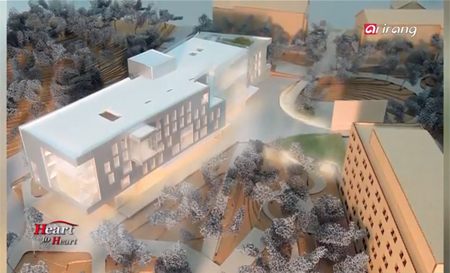
Several of the views are new. The aerial view above looks from north to south and finally explains the plaza area, where Gilman currently connects to Remsen and to the skybridge to Kellogg. According to the video, the building’s classrooms and social spaces were to be located under the plaza (see the second image at the firm’s website).
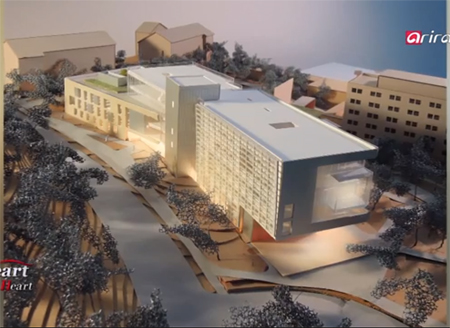
Woo mentions “a social science wing” of the building for the departments of anthropology and sociology. That was probably the south end, visible at left in this north-south view of a model’s College Street facade.
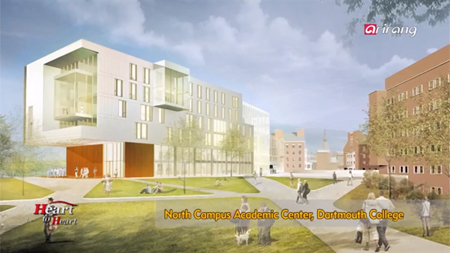
This north-south view shows the Medical School/courtyard facade.
Google updates its aerial, and other news
- Hello, what’s this? The newest Google aerial shows hundreds of chairs and the big Commencement stage set up on the Green. It looks as if the photo was taken just before the Convocation on September 20. It is definitely recent: the Wilson Hall elm is missing, the Crouching Spider is visible, the new scoreboard is casting a shadow on the south end of Memorial Field, the Williamson is under way, Alpha Phi is in place, and the clearing has started for Kappa Delta at the end of Webster Avenue.
- The Planner’s Blog has a couple of photos of the start of the Triangle House renovation. The Trumbull-Nelson magazine has an article on the construction of Alpha Phi and a photo of the Kappa Delta foundation going in.
- Remember the big six-level parking garage in Dewey Field?
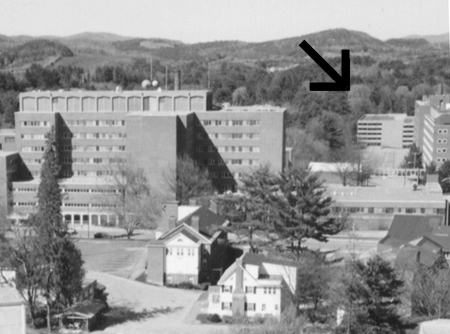
Built in 1972 to hold 490 cars, the garage is visible in this 1995 photo behind Remsen/Vail. The college demolished it in 1996. A Bing aerial shows the current state of the site at the northwest corner of the Dewey Field parking lot, and a Google Street View shows the site from the ground (pan around to see the Google engineers giving the camera trike a sendoff). - It turns out that ADD, Inc., the firm that designed the interior renovations of Home 36 and Home 50, did more than create a new headquarters there for Dana Library. It also created offices there for DCHCDS; and it designed interiors at 4 Currier Place.
- Some notes on education: A small article in Education Life in the Times covers an interesting project, the Minerva Schools. In this attempt to be a non-discount university at a discount price, the idea of renting space in a series of world cities is a neat one. (Also in the supplement is a wordy ad for MALS at Dartmouth (pdf) that seems undesigned — showing directness and honesty, one supposes.) A visit to a Virginia horse fair last weekend turned up booths representing the University of Findlay in Ohio and Centenary College in New Jersey. Interesting. Most of the other booths promoted saddles, animal feed, or pasture fencing.
NCAC now unlikely to come to pass
The Dartmouth reports again, this time with conviction, that the NCAC project as we know it is stalled. It seems as if it might have been effectively cancelled.
Bertaux + Iwerks Architects present an interesting might-have-been, a pre-NCAC design for a new central DMS building. The design would have given DMS a new signature structure and knitted together the existing campus by connecting Vail to Dana and the Life Sciences Center.
It is hard to tell whether this design would have been any more successful as a work of urbanism than the NCAC design, for all its faults. Then again, the NCAC had more space to play with, enjoying the removal of both Dana and Gilman.
Campus construction and other topics
- The Dartmouth has an article on campus construction projects.
- Nice photos of the Visual Arts Center are to be found in ArchDaily (via Dartmouth College Planning).
- The Grad Studies Office is moving from Wentworth to a renovated space at 37 Dewey Field Road (Home 37).
- Bruce Wood at the Big Green Alert Blog has this tidbit regarding Memorial Field: “Keep your eyes peeled for a significant improvement to the facility at some point this fall.”
- Architect Michael McKee was a principal with Moshe Safdie and Associates when he served as a “Special Consultant” with KSWA to handle the design development for the North Campus Academic Center (Somerville, Ma. PowderHouse Arts Center submittal pdf).
- The school has obtained permission from the state to extend the existing floating wharf at the boathouse from 170 ft. to 218 ft. The project will involve dredging (download state letter, wetlands permit, etc.).
- Did you know that there’s a short line called the Claremont Concord Railroad with a transfer facility in West Lebanon near the dilapidated old B&M roundhouse? In this aerial, the red Four Aces Diner is visible in its new location and the Railroad’s classic early-1950s Alco (?) is the yellow engine on the left.
- DartmouthSports.com has announced that NeuLion will stream home games in several sports (via the Big Green Alert Blog). NeuLion is the leader in the field, and it seems to be moving away from a dependence on Flash. (Flash has a bad reputation on the desktop, see Steve Jobs’s letter of April 2010, and does not work on many mobile devices: Adobe announced in November 2011 that it had halted the development of Flash for mobile browsers according to Wikipedia.)
Academic Center site plan released
Architect Michael McKee was a Senior Project Manager with KSWA when that firm designed the North Campus Academic Center. Now he has his own firm, and its website includes a page on the NCAC. It says that the project is “On hold, to commence Fall ’13.”
The page includes an interior rendering and a site plan. This website’s guess at a likely footprint last November was actually not that far off.
—–
[Update 08.31.2013: Broken link to KSWA replaced.]
Academic Center flux
An article in The Dartmouth states not only that the North Campus Academic Center is delayed and that its projected inhabitants are changing, with DCHCDS and DICHCP moving to the Williamson, but also that past problems have included “the Board of Trustees’ disapproval of the building’s design.” Is that why it seems to have gone from partial brick to all-white?
One wonders whether a new president might bring in his own favored designers.
ADD, Inc. designed the renovation of a part of the Nurses’ School dormitory Home 37 (a.k.a. 37 Dewey Field Road) to house Dana library until the Academic Center is built. The Planner has photos of the colorful work.
An article in the Valley News includes a perspective rendering of the Williamson Translational Research Building at DHMC (small version in DICHCP press release).
—–
[Update 04.25.2013: Alex Atwood has a photo of a nice model and some sectional renderings of the NCAC.]
An aerial view of the Academic Center’s site
Bill Hemmel has a nice collection of recent aerial photos of the campus, including this one:

Dartmouth will demolish Gilman (at right, with white window frames) and Dana (the square building above it) to provide a site for the North Campus Academic Center.
At this stage in the design process, the siting of the Academic Center is the best and most interesting attribute of the building. Disobeying the grid that orients the rest of the medical school complex, the Academic Center will approximate the curve of College Street. Here is a very rough guess at the building’s footprint:
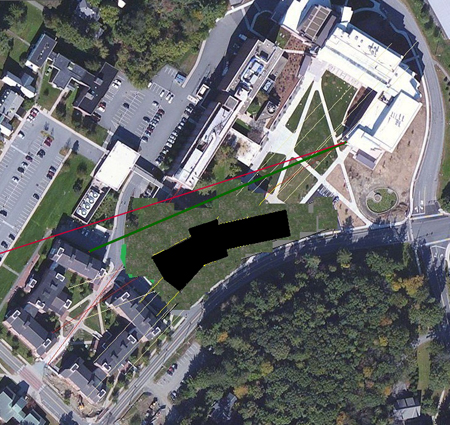
This would seem to rule out a New Maynard Street (not a serious idea):
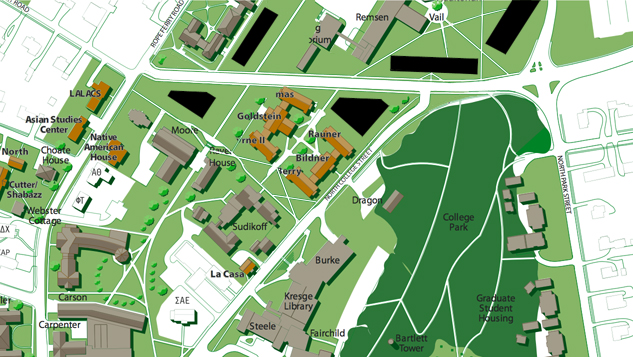
The new building will wall off the medical quad from the street at least as much as Dana does now, and it will finally liberate the quad’s southwestern corner. In place of the frustrating and obstructive hyphen that new joins Gilman to Remsen, the new building will erect a broad ramp to give pedestrians free access to the quad and the Life Sciences Center beyond.
In the context of Vail and its older neighbors, the potentially dull, planar surfaces and ominous cantilevering of the new building might be hard to criticize. This is Dana’s entrance, for example:
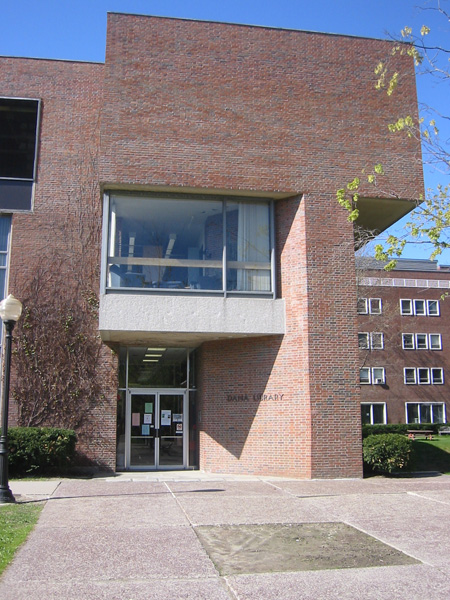
But the obvious difference is that the med school’s Modernist buildings, all by SBRA, are built of red brick. While their scale and style set them apart, their material ties them to the campus. The Academic Center, which initially was shown as having one portion clad in brick, appears to be destined to wear a museumlike white material, possibly stone or metal paneling, all the way around.
The building guidelines in the 2002 Campus Master Plan propose that new buildings maintain at least some connection to the old:
There is a predominance of red brick buildings in Flemish bond, vertical, white, multi-paned windows, entry pediments, and pitched copper roofs. While we do not believe it desirable to limit the design of new buildings to a particular style, the use of some of these existing elements can go a long way in linking the new with the old.
Since it seems to be important to use color to set the Academic Center apart, one wonders whether the building could be built of white-painted brick. The oldest buildings of the campus, those of Dartmouth Row, have been painted white for decades, and yet they have been so little imitated that they remain strikingly different.
—–
[Update 11.17.2012: Broken link to Dana image fixed.]
Academic Center cutaway
KSWA has published a view of a cutaway model. The firm explains:
The new Dartmouth North Campus Academic Center, currently in Design Development, is organized like a small village. Two-storey office “Community Spaces” step down from both ends to a Forum and Cafe as “Town Hall,” which opens to a “Town Center” in the form of an outdoor plaza.
More details on the Academic Center, Dana’s move
The previous post on this topic mentioned that the current rendering (source) of the quad facade differs slightly from an earlier rendering published during May. Some of the changes:
- The eastern (most distant) of the three masses has gone from light-colored stone cladding to something more uniform, possibly metal, and has gained a glazed projection or Window of Appearance. The mass also appears to have taken on a stepped form where it meets the rest of the building.
- The central mass is still a glass box, but the detailing has changed. The third level seems to have been omitted or made into a mezzanine.
- The nearer, western mass has changed from red brick to stone or concrete. The walls of the ground level are largely blank, suggesting that this part of the building will house Dana Library.
Where will Dana go between the demolition of its current building in 2013 and the completion of the new one in 2016? It will occupy Homes 37 and 50, former Nursing School buildings that are now known, as a result of two of the school’s better E-911 naming decisions, as 37 and 50 Dewey Field Road.
The Biomedical Libraries Blog has a plan of the library in its temporary home, with the layout designed by ADD Inc.
—–
[Update 03.31.2013: Broken link to library plan replaced.]
[Update 11.17.2012: Broken link to library blog fixed.]
[Update 08.19.2012: It looks as if the addresses of the buildings at 37 and 50 Dewey Field Road have been consolidated, and the building built in 1950 (i.e. Home 50) is now numbered 37 Dewey Field Road.]
The Academic Center is by Kyu Sung Woo Architects
The designers behind the planned North Campus Academic Center are the Cambridge, Mass. firm of KSWA. Firm founder Kyu Sung Woo (Wikipedia) designed the Olympic Village for the 1988 Olympics in Seoul (firm page).
The firm’s campus work includes a pair of dorms on Coffin Street at Bowdoin (firm page) and the Nerman Museum in Kansas (Architectural Record, Biemiller post at the Buildings & Grounds blog of The Chronicle).
The project page for the North Campus Academic Center at Dartmouth provides a slightly modified version of the May view of the building’s rear or quad facade as well as a view to the southwest showing the “front” facade on College Street.
What’s most notable is the siting: this building has some major planning implications. The building is not an east-west bar as its predecessor Gilman was. Instead, it appears to follow a northeast-southwest orientation, forming an angled tee shape (a favored form — see the Nerman plan). The dominant main block will follow the angle of College Street as it heads off toward Lyme. The southern end of the building, the stem of the tee, appears to adopt the orientation of the McLaughlin Cluster.
Thus, instead of forming a rectilinear wall along the bottom of the medical quad as Gilman did, the building opens like a trap door, allowing the quad to spill out to the McLaughlin Cluster.
Some new details about the building’s contents and surroundings:
Classrooms, meeting rooms, a graduate student lounge and social space, a cafe, and a large scale forum will be available to the Dartmouth community. The building will be set in a landscape featuring outdoor performances, art events, and a gathering space for major events such as the Medical School commencement.
The Life Sciences Center also was described as framing a space for commencements. Thus the commencement space mentioned above seems likely to be the existing medical quad rather than the sunken lawn visible in the first illustration.
———-
[Update 08.11.2012: KSWA’s authorship of the Academic Center was mentioned as early as March 9 on a Korea.net article titled “Design by Korean architect dazzles in Boston.”]
An Academic Center update
A memorandum published in connection with the Academic Center/Williams bond (pdf) states on A-9 and A-10 that the North Campus Academic Center will replace Gilman and Dana, is scheduled to begin during July of 2013, and is expected to be substantially complete by March of 2016.
The building is planned to house the Departments of Sociology and Anthropology (the college was mum about this in an article in The Dartmouth, and the plan might still be in flux); the Center for Healthcare Delivery Science; the Institute for Health Policy and Clinical Practice; Dana Biomedical Library; and the administration of the Geisel School.
Elsewhere, it is noted that the Academic Center is a registered LEED project.
And what about the bridge to Kellogg — will it survive? It could be hidden behind the screen visible on the left side of the image published here recently.
Will Dartmouth demolish Gilman and Dana?
At Commencement the Board announced the construction of the Williamson Translational Research Building at the hospital (a project announced in 2007) and, more notably here, of a “North Campus Academic Center” (Dartmouth Now via Jon).
The Academic Center will contain classrooms, academic offices for DCHCDS and other programs, and the Dana Biomedical Library, an institution that currently occupies its own building. The Center might be made up of multiple buildings: “Dartmouth director of project management Matt Purcell says that the school … is developing two buildings for its new North Campus Academic Center” (Real Estate Bisnow Boston).
An overlooked document from a conference last month (pdf) includes a rendering of the buildings:
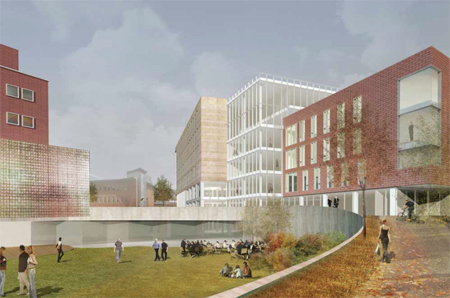
That brick building behind the new screen on the left is Remsen. Compare this view:
The buildings shown in the rendering occupy the sites of Gilman and Dana. Those buildings are not particularly popular, and their demolition would have been good to mention in the press release.
Acknowledging that the rendering probably does not represent a final design, what can be said about the project? It looks better than Gilman. The far block, with its stone (?) cladding, might be the library replacement. The less pretentious near block, of brick-red cast masonry units (?), is probably the classroom building. Between the two is a glazed tower. The sweeping concrete wall and bridge is a bit too Fairchild, but it should improve the circulation in the area and make the Medical School more porous and campuslike.
The rendering above was an interesting one to choose as the representative of this project: it is not the view from the street or from the center of campus. Instead, it looks to the northwest from around the center of the left edge of this aerial:
If Gilman is to go, the school should save the wonderful (Scotford-designed?) lettering from its entrance and the polite sculpture that is affixed to the east end of the building.
Townscape: The view from Sudikoff.
Even though Gilman long predates the McLaughlin Cluster, it provides a not-bad terminus for the Cluster’s main vista. The new academic centers building now has an opportunity to provide an intentional northern end to the axis. Without being heavy-handed or obvious, this building also could provide a gateway to the medical school — perhaps not Seussian gargoyles (a fertile field…) but some acknowledgment, such as a pedestrian passage or an inscribed granite lintel, that this is where one institution ends and another begins.
—————-
[Update 07.07.2012: Townscape information and better comparison image added. The gold lettering visible in a photo from The Dartmouth is the salvage-worthy Gilman detail referred to above. It seems from the photo to be painted on the transom. If that panel is removed and is not installed in the replacement building, what happens to it? What happens to all the notable elements that surely are removed from demolished buildings? Until there is a Dartmouth Museum, they could be displayed in the studios at 4 Currier or the VAC. (Dartmouth could indeed build a museum to its own past and stock it with the realia now in the archives.)]
The 122,000-square foot North Campus Academic Center is scheduled to contain:
- 18 classrooms
- the Dana Biomedical Library
- interdisciplinary space for the Geisel School of Medicine; the Dartmouth Institute for Health Policy and Clinical Practice; the Dartmouth Center for Health Care Delivery Science; and the Department of Sociology
Sources: Dartmouth Now and Tradeline.]
[Update 08.12.2012: There is other lettering at the east end of Gilman as well.]